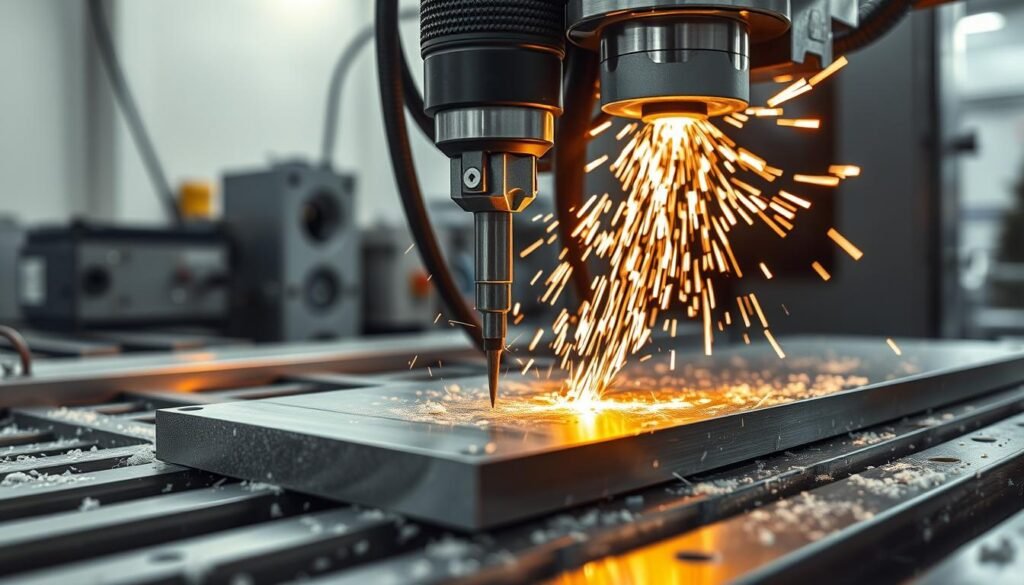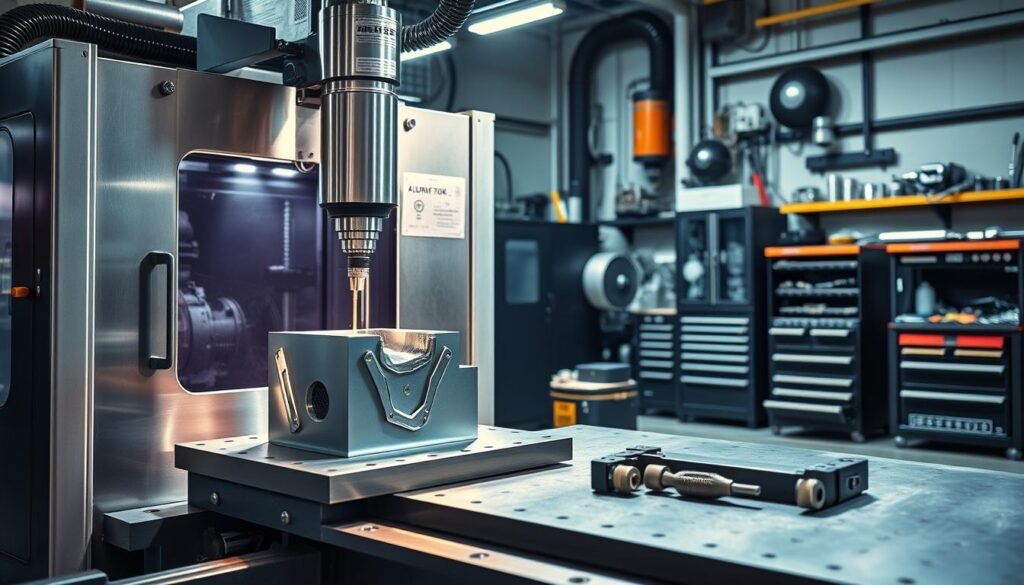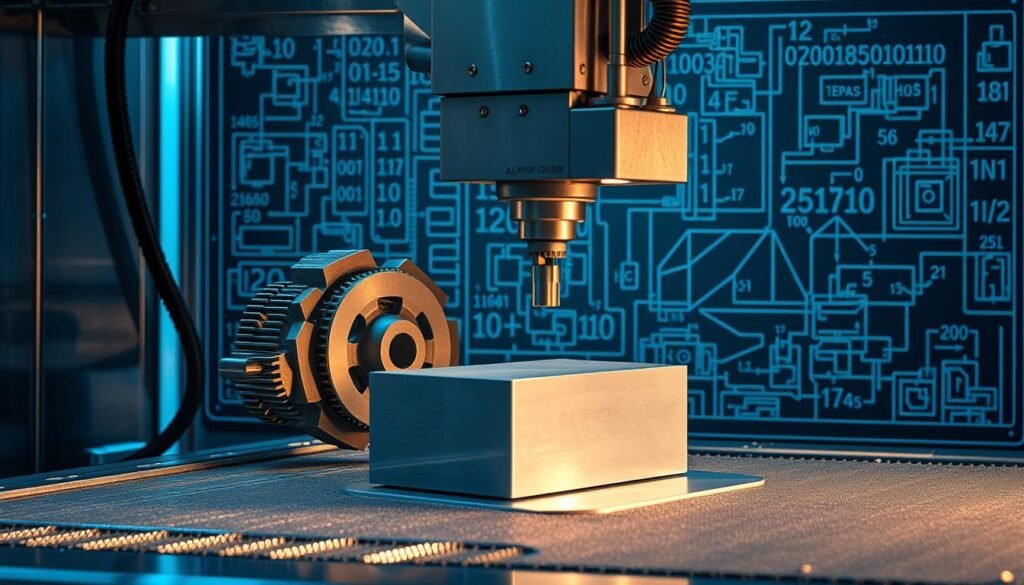Welcome to our detailed guide on aluminum CNC machining. This process is key in many industries because of its efficiency and aluminum’s great properties. Aluminum is light but strong, perfect for many fields like aerospace and electronics.
This guide will dive into the details. We’ll share expert tips on aluminum CNC machining, its materials, and uses. It’s all to help improve your machining projects.
Key Takeaways
- Aluminum is one-third the density of steel, great for cars and planes.
- Pure aluminum is very good at conducting electricity, about 37.7 million Siemens per meter at room temperature.
- Aluminum 6061 is versatile and used in many fields, like buildings and space.
- Machining aluminum is cheaper and faster than steel because it’s softer.
- Aluminum alloys resist corrosion well, with the 5000 series best for the sea.
Now, let’s explore precision aluminum machining. We’ll look at different aluminum alloys and the best ways to machine aluminum. This guide will be your go-to for perfecting aluminum CNC machining. Stay with us as we cover every important part of this key process.
Introduction to Aluminum CNC Machining
Aluminum CNC machining has changed the game in manufacturing. It combines precision with speed. Using computer numerical control (CNC), we make parts with high accuracy and consistency. In 2023, the world made about 67 million tons of primary aluminum, showing its big role in making things.
Aluminum is great because it’s strong but light. It’s about one-third the weight of steel. This makes it perfect for cars and planes. Aluminum 7075, used in planes, gets very strong when treated right, showing its strength.
The CNC aluminum machining process includes milling, turning, and drilling. These steps help make complex parts with great precision. CNC milling machines, with 2 to 12 axes, can do detailed work. The aluminum milling guide helps with the best cutting speeds and tools.
Aluminum is easy to machine, taking less time than steel or titanium. This means we save on labor and time. Plus, aluminum is recycled a lot, helping the environment.
Our services cover many areas, like aerospace and electronics. Aluminum is good at resisting corrosion and conducting heat. For example, the 5000 series alloys are great for ships because they resist corrosion well.
It’s important to know how aluminum works in CNC machining. Things like thermal expansion and chip formation matter. Using cutting fluids helps avoid problems, keeping quality high.
In short, aluminum CNC machining is key in making things better and faster. By understanding how it works, we can make top-quality products that meet high standards.
Properties and Advantages of Aluminum in CNC Machining
Aluminum is a top choice in CNC machining because of its great properties. It’s strong, light, and easy to machine. This makes it perfect for many high-performance uses.
Its many benefits help in making precise cuts. This is key for creating top-notch parts.

Strength-to-Weight Ratio
Aluminum’s strength-to-weight ratio is a big plus. Most aluminum alloys are stronger than stainless steel 316L. This is why it’s so valuable in aerospace and car making.
The 7075 grade is known for its strength. It’s great for making reliable parts for planes.
Corrosion Resistance
Aluminum fights off corrosion well. It has a protective layer that helps it last longer. The 5083 grade is even better for salty environments.
This makes aluminum perfect for harsh places. Anodizing can make it even better, adding extra protection and looking good.
Machinability
Aluminum is easy to machine, which saves time and money. Metals like 6061 are easy to weld and shape. This makes making parts faster and cheaper.
Alloys like MIC-6 let for fast cutting without messing up the shape. This shows how important aluminum CNC cutting techniques are for making parts just right.
Common Aluminum Alloys Used in CNC Machining
Choosing the right aluminum alloy is key in CNC machining. Each series has its own strengths for different uses. It’s important to know what each series can do.
1000 Series
The 1000 series is mostly pure aluminum, at 99%. It’s great at fighting corrosion and conducting heat and electricity well. But, it’s too soft for most CNC parts.
2000 Series
2000 series alloys have copper, making them strong and easy to machine. The 2024 alloy is strong and lasts long, perfect for planes. The 2024-T4 is even better for high-stress jobs.
6000 Series
The 6000 series, like 6061, is strong, resistant to corrosion, and easy to work with. 6061 is great for many uses, from buildings to car parts. 6082 is stronger and fights corrosion well, ideal for tough jobs.
7000 Series
7075 aluminum and others in the 7000 series are as strong as steel. They have zinc, making them hard and strong. 7075 is used in planes and where things need to last a long time. The 7075-T6 is even stronger, but more expensive and less flexible.
Aluminum CNC Machining Processes
In the world of making things, knowing about aluminum CNC machining is key. It helps us make things with great precision and speed. We use CNC milling, turning, and drilling to meet many needs, making sure everything is top-notch.
CNC Milling
CNC milling is a big deal in making aluminum parts. It uses tools that spin and move to shape parts. This is great for making complex parts for cars and planes.

CNC Turning
CNC turning is another important method. It turns the aluminum against a tool to make symmetrical parts. This is how we make rods, shafts, and fasteners with high precision. It’s used a lot in making cars and electronics.
CNC Drilling
CNC drilling is all about making precise holes for parts to fit together. It’s much better than old ways of drilling. It’s perfect for making things for planes and cars where everything has to fit just right.
Understanding the Aluminum CNC Machining Cost Drivers
Aluminum CNC machining costs are influenced by many factors. Knowing these helps in finding cost-effective solutions. The type of aluminum alloy used is a big factor. For example, 6061-T6 costs about $6 per pound, while 7075-T6 can be up to $80 per block.
Prices for aluminum alloys vary from $10 to $50 per kilogram. This depends on the specific alloy.
The part’s complexity also affects costs. More complex designs need advanced machines. These can cost over $50 per hour. Standard machines cost around $20-$30 per hour.
Setup and programming can add up to over $200 per hour. This depends on the design’s complexity.
Labor costs are also important. Labor for 3-axis machines is about $10 per hour. But, achieving high-quality finishes can increase costs a lot. Post-processing, like anodizing, can cost from $50 to over $500.
Manufacturers can lower costs by using smart strategies. For example, high-efficiency machining (HEM) can save a lot. An aerospace company cut costs by 30% with HEM.
An automotive parts maker also saved 25% by making more parts at once. Standardizing designs helped.
Using Design for Manufacturing (DFM) can also save money. A medical device company cut costs by 40% by improving workflow and using lean principles.
Producing more parts also lowers costs. Making 1,000 units is cheaper than making 10. This is because setup costs are spread out.
Here’s a summary of what affects CNC machining costs:
| Cost Factor | Impact | Details |
|---|---|---|
| Material Costs | High | Price variation between alloys (e.g., $6 per pound for 6061-T6 vs. $80 per block for 7075-T6) |
| Setup and Programming | Moderate to High | Can exceed $200 per hour, influenced by part complexity |
| Machine Costs | Variable | $20-$30 per hour for 3-axis machines; >$50 per hour for advanced machines |
| Labor Costs | Low to Moderate | Around $10 per hour for 3-axis machines |
| Post-Processing | Moderate | $50 to over $500 based on complexity |
| Production Volume | Significant | Higher production volumes reduce costs per part |
Choosing the right aluminum alloys and efficient machining is key to saving money. For more on aluminum CNC machining, check out the “Ultimate Aluminum CNC Machining Guide for Experts”. For details on precision CNC turning for aluminum parts, see our guide here.
Tips for Precision Aluminum Machining
To get precision in aluminum machining, you need a smart plan. This plan should look at many things. It aims for top CNC machine accuracy and the best results.
Selecting the Right Cutting Tools
Picking the right cutting tools is key for precision aluminum machining. Tools made of carbide and diamond are great. They wear down less and cut better.
It’s important to find the right balance between cutting speed and tool material. This keeps the tool sharp for a long time and precise.
Using Cutting Fluids
Using cutting fluids is very important. They help lower friction and cool down the machine. This makes the surface smoother, the tool last longer, and the CNC machine more accurate.
We suggest using fluids made just for aluminum. This makes sure you get the best results and quality.
Securing Workpiece
Keeping the workpiece steady is crucial for getting the right size in aluminum machining. Good clamping stops it from shaking or moving. This keeps the final product precise and of high quality.

Using these tips in your work can really improve the quality and accuracy of your CNC machined parts. With practice and focus on precision, you’ll see better results. Your customers will be happier too.
Surface Finishing Techniques for Aluminum CNC Parts
The art of aluminum surface finishing is key to making CNC parts look good, last long, and work well. The right finish can make a big difference. We look at three main methods: anodizing, powder coating, and sandblasting.
Anodizing
Anodizing aluminum makes it stronger and more resistant to rust by adding a protective layer. It starts with dipping the metal in acid and using electricity to create this layer. It’s popular in aerospace, cars, and gadgets for its looks and strength. Anodized aluminum can also be colored, adding to its appeal.
- Durability: Parts last longer because they’re harder.
- Corrosion Resistance: Parts stay in good shape longer.
- Aesthetics: Parts look better with many color options.
Powder Coating
Powder coating aluminum uses a dry powder that’s applied and then baked on. It’s known for being tough, scratch-resistant, and good in harsh weather. It’s used a lot in cars and factories. Powder coating makes parts a bit bigger but is cheaper for big orders.
Sandblasting
Sandblasting uses fast-moving sand to clean and texture aluminum. It’s great for getting rid of marks and making surfaces ready for other treatments. It makes parts look better by giving them a smooth or textured finish. It’s simple but very important for finishing aluminum.
- Pre-Treatment: Prepares parts for other finishes.
- Texture Improvement: Gives parts a smooth look that hides flaws.
- Enhanced Adhesion: Helps paint and coatings stick better.
Choosing the right surface finish is very important. Knowing about anodizing, powder coating, and sandblasting helps make sure CNC parts are top-notch. Each method has its own benefits for different needs, making sure parts are precise and of high quality.
Best Practices for Aluminum CNC Programming
Effective aluminum CNC programming boosts machining efficiency and part quality. It’s important to optimize cutting paths, pick the right speeds and feeds, and use strong CNC setup techniques.
First, optimizing cutting paths is key to save time and reduce tool wear. We can simulate different paths to find the most efficient one. This ensures precise and high-quality results.

Next, optimizing CNC code is crucial. Using best practices helps tools work smoothly and consistently. For example, a cavity depth of four times the width improves precision and tool life. Also, 5-axis CNC machining creates intricate paths for better surface finishes.
Choosing the right speeds and feeds is essential. It keeps tools from wearing out too fast and works efficiently. For deep cavities, tools up to 30:1 ratio can reach 35 cm deep with a 1-inch end mill.
Managing internal stresses in aluminum is also important. Techniques like vibration and thermal treatments help. The right tools, like carbide or diamond-tipped, also play a big role in precision and tool life.
Lastly, precise CNC setup techniques are vital for accuracy. Hole diameters should match drill bit sizes, and walls should be at least 0.8 mm thick. This prevents deformation and ensures part dimensions are consistent.
By following these best practices, we can make high-quality parts and improve our machining efficiency.
Challenges and Solutions in Aluminum CNC Machining
Aluminum is great for machining and has many uses. But, there are still problems to solve. We need to handle thermal expansion, tool wear, and chip control to get the best results.
Thermal Expansion
Thermal expansion is a big challenge. Aluminum changes size with temperature changes. To fix this, we use special environments and coolants.
Keeping the temperature steady helps avoid mistakes. This makes our parts more precise.
Rapid Tool Wear
Aluminum can wear down tools fast. This hurts both speed and quality. We use strong tools and coatings to last longer.
Good coolants also help. They make the process smoother and reduce wear.
Chip Formation
Controlling chips is key for good parts and smooth work. Bad chip control can break tools and ruin surfaces. We use the right cutting and chip control methods.
Things like high-pressure coolants and chip breakers help. They keep the material flowing and the process going.
Conclusion
Learning about aluminum CNC machining is key for industries needing precision and quality parts. Aluminum makes up about 8% of the Earth’s crust. It’s strong, easy to machine, and resists corrosion well.
This guide has covered aluminum’s properties, machining processes, and best practices. It helps improve CNC techniques and make machining more efficient.
The aerospace and automotive industries use a lot of aluminum. It’s used in 80% of an aircraft’s structure and makes cars lighter. CNC machines can work fast with aluminum, up to 200 inches per minute.
Aluminum alloys, like the 2000 and 5000 series, are very strong and resistant to corrosion. This makes aluminum a great choice for many applications.
Exploring aluminum CNC machining shows the need for constant innovation. Using aluminum well means making high-quality parts at a good price. For more info, check out our full guide on aluminum CNC machining.
By following these practices, we can improve our work and stay ahead in precision engineering. We’ll be ready for the changing needs of different industries.
FAQ
What makes aluminum ideal for CNC machining?
Aluminum is great for CNC machining because it’s strong yet light. It also doesn’t rust easily and is easy to machine. This makes it perfect for making strong, light parts.
What are the common aluminum alloys used in CNC machining?
In CNC machining, you often see 1000 series aluminum. It’s good for fighting corrosion and conducting heat. The 2000 series is strong, often used in planes. The 7000 series is even stronger, great for planes and sports gear.
What are the primary aluminum CNC machining processes?
Main processes include CNC milling for detailed parts, CNC turning for symmetrical parts, and CNC drilling for precise holes. These are key for parts that need to be bolted or riveted.
How can I manage the costs of aluminum CNC machining?
To save money, pick the right aluminum type and design parts well. Use efficient machining methods. Costs depend on material, setup, labor, and tool wear.
How do you achieve precision in aluminum CNC machining?
For precision, choose the right tools and use coolants to control heat. Make sure the workpiece is clamped well to avoid movement.
What are effective surface finishing techniques for aluminum CNC parts?
Good finishes include anodizing for protection and powder coating for a strong layer. Sandblasting cleans and textures the surface for better looks or treatments.
What are the best practices for aluminum CNC programming?
For top programming, plan cutting paths well, pick the right speeds and feeds, and manage tools. This cuts down on time and cost while keeping parts precise and strong.
What challenges are associated with aluminum CNC machining and their solutions?
Issues like thermal expansion can be fixed with controlled environments and coolants. Tool wear can be lessened with durable tools. Chip formation is managed with special techniques.


